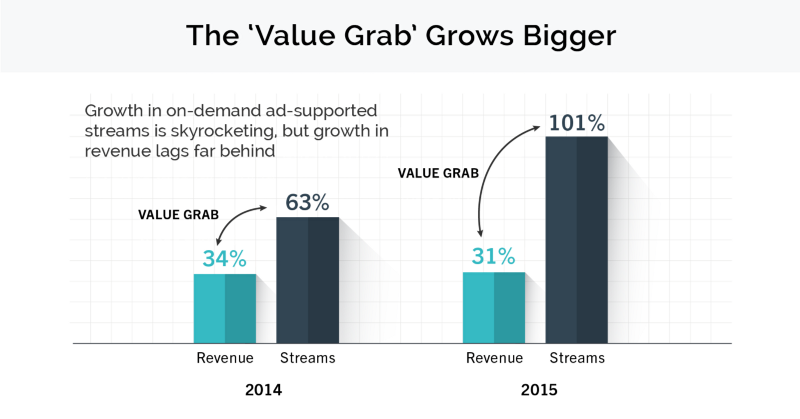Streaming is now the biggest revenue stream for the music industry in the US, generating $2.4 billion in 2015. The RIAA has released its report on the state of the US music industry in 2015, and streaming music has edged out digital downloads in revenue for the first time. After declining last year, the music industry as a whole grew once again in 2015, selling $7 billion worth of music, a 0.9 percent increase from the year prior. Despite declines in digital downloads and physical sales, streaming music has managed to keep the industry on an upward trajectory.
"In 2015, digital music subscription services reached new all-time highs, generating more than $1 billion in revenues for the first time, and averaging nearly 11 million paid subscriptions for the year," RIAA CEO Cary Sherman said in a memo sent out with the report. "Heading into 2016, the number of subscriptions swelled even higher — more than 13 million by the end of December — holding great promise for this year."
Streaming music has managed to keep the industry on an upward trajectory
Sounds like the RIAA and the labels it represents are happy, right? Wrong. The industry is upset about something they have been upset about for years — on-demand ad-supported streaming. YouTube and Spotify's free tier are the two main examples, but the RIAA is focused on YouTube this time around, and this is as solid as their argument has ever been. "The consumption of music is skyrocketing but revenues for creators have not kept pace," Sherman wrote. "In 2015, fans listened to hundreds of billions of audio and video music streams through on-demand ad-supported digital services like YouTube, but revenues from such services have been meager — far less than other kinds of music services."

The RIAA and the labels' argument is this; streams of ad-supported music are rapidly increasing but the revenue isn't matching the growth. Ad supported streaming brought in $385 million in revenue in 2015 from billions of streams, which is a nice chunk of change. But vinyl sales — which have dramatically increased over the past few years thanks to a resurgence of the physical format — brought in $416 million in revenue in 2015.
Is it an odd fact that vinyl records are more profitable for the music industry than YouTube? Yes. On the other side of the argument, as sources close to YouTube have said time after time, the billions of streams it generates gives the music labels promotional benefits that cannot be garnered elsewhere, and the infrastructure costs of running a video serivce far outweigh those of an audio-only service.
"comparisons to other audio-only, subscription music services are apples to oranges."
In a statement to The Verge, YouTube said as much, noting that it has paid out $3 billion to the music industry (which matches Spotify's payments). "To date, Google has paid out over $3 billion to the music industry – and that number is growing year on year," a YouTube Spokesperson said.
"This revenue is generated despite the fact that YouTube goes way beyond music to include popular categories such as news, gaming, how-to, sports and entertainment. And with the recent launch of the YouTube Music app, we now have a dedicated music experience that will deliver even more revenue to both artists and the music industry more broadly. Past comparisons to other audio-only, subscription music services are apples to oranges."

And why isn't the RIAA focusing on Spotify, who also offers up free streams? Likely because Spotify has a 25 percent conversion rate moving users from its free to paid tiers, and paid users are where the real value is. Despite the US only having 10.8 million paid users for most of last year (that number is at 13 million as of December 2015), those users generated $1.2 billion in revenue for the music industry. That's more revenue than digital album sales made in 2015.
Although the music industry is reengaging in this longstanding squabble with YouTube, the answer for both parties is one that makes them both more money: YouTube Red. The simple answer is for YouTube to continue to push its subscription service, which pays out at a much higher rate than its free option, and makes everyone more money. If YouTube gets anywhere remotely close to Spotify's conversion rate — which won't be easy in the least — this problem goes away, and we can all go back to wondering how we let the whole Iggy Azalea thing happen.
:format(webp)/cdn.vox-cdn.com/uploads/chorus_asset/file/15739233/mus1.0.0.1458673660.jpg)